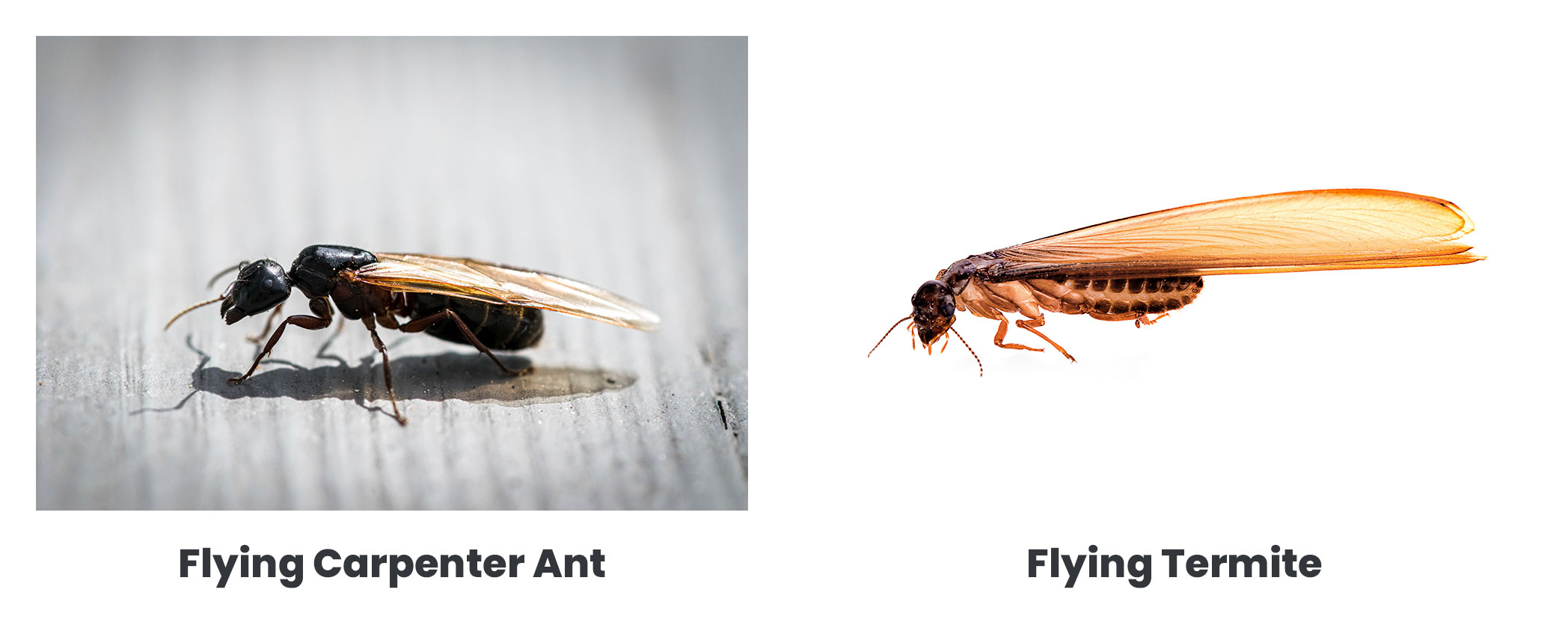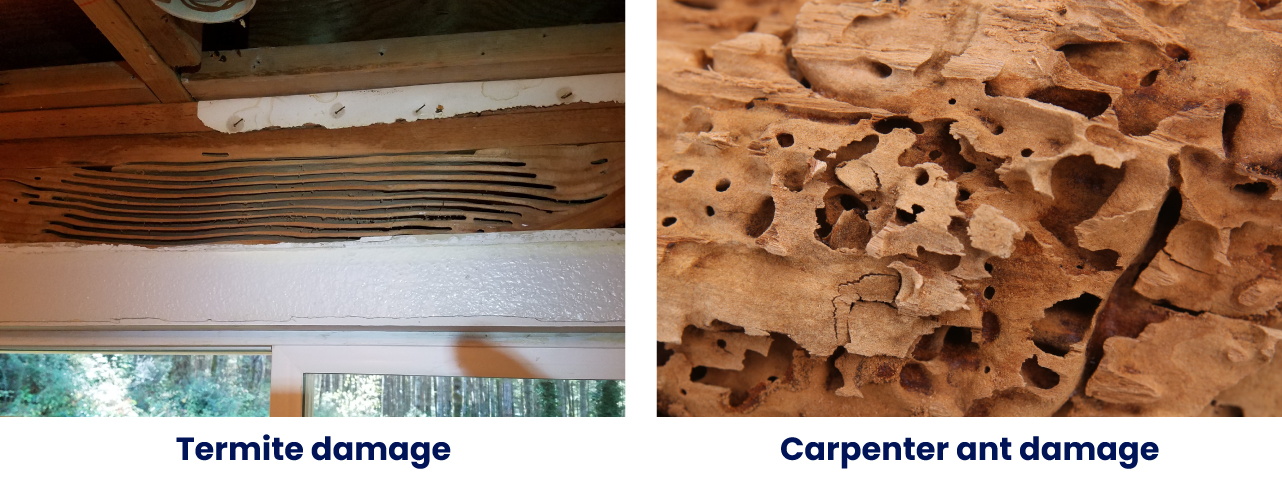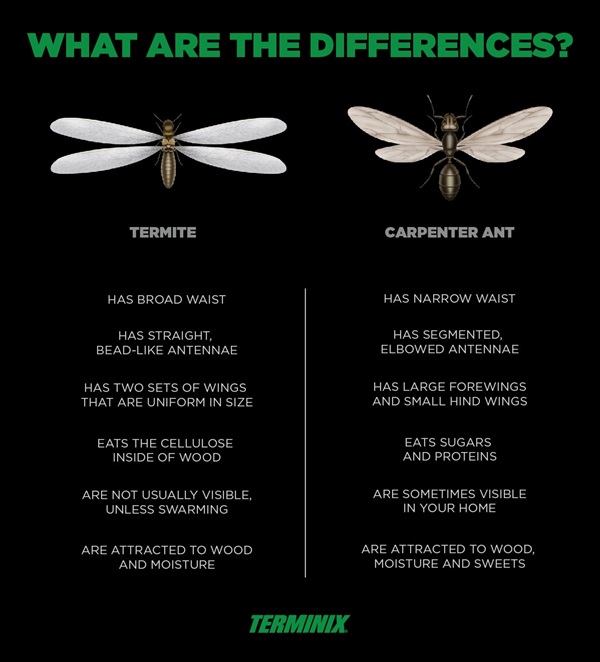Take a look at the differences between termites and ants, specifically carpenter ants.
Contributed by: Doug Webb
Updated on: October 25, 2022
Both ants and termites swarm when it's time for mating, and both are known for causing damage to wood. In fact, there are many species of ants that swarm and may be confused with termite swarmers. However, these two insects have far more differences than they do similarities.
And while many ant species swarm and have wings, we're going to focus on carpenter ants as they are more commonly confused with termites due to their wood-damaging tendencies. In this article, we'll point out how to tell the difference between ants and termites.
Need a visual example before we dive in? Take a look at the differences between termites vs. flying ants, specifically carpenter ants.
Physical differences
At a passing glance, ants and termites look similar. However, when you compare the two insects – particularly winged ants and termites – there are quite a few physical differences.

Body shape
One of the key differences between termites and ants is the shape of their bodies. Carpenter ants, along with other ants, have narrow "waists." Termites, on the other hand, have more broad "waists."
Antennae
Termite antennae are unique from those of ants because they are straight, but look as if they are comprised of little beads or balls. Ant antennae are distinctly elbowed.
Wings
Remember that only reproductive stage carpenter ants and termites have wings and swarm from the colony. There are a couple of ways to tell them apart, though these identifiers may be difficult to see.
Both insects have two sets of wings. Termites' wings are pretty much uniform in size while ants have two large forewings and two smaller hind wings. Sometimes you may only find wings. And if they're all the same size and shape then they are probably termite wings. If the wings are different shapes and sizes, then they are probably ant wings.
Color differences
Both ants and termites come in a variety of colors. Ants are typically black, although there are some species that are a deep shade of red. Termites, depending on their species and place in the hierarchy, can range from dark brown to a lighter, creamy tan or white hue. Some species and castes of termites can be translucent in their appearance, while most ants (with the exception of ghost ants and pharaoh ants) are opaque.
Diet differences
Termites are known for eating wooden structures because they need the cellulose within the wood to survive. Do carpenter ants eat wood? No. Rather they make their homes in the wood, excavating the shavings as they burrow further into structures. Unlike termites, carpenter ants' diets consist of other insects and they are unable to digest cellulose for nutrition.
Visibility differences
A termite's habitat depends on the termite species. Unless you spot a swarm, you're more likely to spot signs of termites rather than the actual insects. Key signs that you have termites include discarded wings, mud tubes and wood damage for subterranean termites. Termite pellets, or "droppings," can be a sign of drywood termites. Carpenter ants, on the other hand, will venture out to forage for food, so you may actually see them in your home. They also kick "frass" out of their nests which might be spotted on floors or other horizontal surfaces. Carpenter ant frass usually contains wood shavings and parts of dead insects.
Differences in attractants
Moisture in your home is conducive to both ants and termites. Naturally, they're also both attracted to wood and easy points of entry. However, that's where the list of what attracts carpenter ants and termites begins to deviate.
Another difference between termites and ants is that the carpenter ants don't eat wood (as mentioned above), so they'll be attracted to other sources of food, and may be seen wandering on window sills and baseboards.
Life cycle differences
Although termites and ants have similar types of hierarchies and caste systems within their colonies, on the whole, termites live longer than ants.
Some species of termite queens are able to live for more than 30 years in some cases. However, most termite queens live between 10 to 12 years. In comparison, ant queens only have a 10-year lifespan, although some ant species' queens can live for nearly three decades. Comparatively, termite workers live for about two years while female worker ants may only live for a few months and male worker ants may only live for a few weeks and die after mating with their queen.
When it comes to life cycles, termites and ants are similar, but slightly different. Ant eggs hatch within one to two weeks before they graduate to the larval stage – roughly six to 12 days. Ant larvae will molt a few times before they enter the pupae stage, in which they spin a cocoon before emerging as an adult ant within a span of one week to one month.
Termites also begin as an egg before graduating to the nymph (or larval) stage. Termite nymphs can molt up to three times before they become an adult and are assigned a role within their colony.
Termite and carpenter ant behaviors: damage differences
Physical characteristics are not the only things that differentiate these two pests. The type of damage they cause to wood can help you determine which pest is responsible.
Though both pests infest wood and other cellulose based materials, carpenter ants do not actually eat wood. Instead, these pests seek out softer, wet, or rotting wood in order to start building their nests. Once the nest is established they will tunnel into sound wood. The leftover wood then gets pushed out through the entrances to these tunnels, which can result in piles of wood shavings collecting near these entrances. Likewise, wood near the tunnels may appear to be chipped or scraped, though the insides of these tunnels often appear smooth and polished.

In contrast, termites do actually eat wood, and these pests are not picky; they will eat both healthy and weakened, rotting wood, if necessary. Because termites typically travel through the ground to reach their new wood habitat, they bring with them a mixture of mud and soil that they track into the tunnels.
Homeowners with subterranean termite damage may begin to see long mud tubes running from the ground to the termites' tunnel entrances. Likewise, as these pests eat, they excrete dark pellets that are pushed out of the tunnel openings and often collect on nearby surfaces. If the termite damage is being inflicted within a home's interior or wooden furniture, the wood may begin to blister, peel, or grow discolored spots across the surface, but most often the wood shows no evidence of termite infestation at its surface.
However, these pests do have some similarities when it comes to their tunneling behavior. Both reproductive ants and termites leave their colony and can appear in droves as they swarm to find mates and new nesting sites. This only happens when conditions are correct, and while it often occurs during the spring or early summer, it can also occur at other times of the year as well. For both ants and termites, the swarmers are just a small fraction of the total colony. For every swarmer seen there may be up to several thousand worker termites working behind the scenes.
However, it's not these winged termite or ant swarmers that cause damage. Rather, it's the respective colonies of carpenter ants and termites that cause damage to wood. Once a new colony is established, these pests will chow down on the available wood 24/7. Though both pests work exhaustively, it can sometimes take years for damage caused by these pests to become noticeable.
While both pests have strong jaws that allow them to chew through solid wood fibers, neither carpenter ants nor termites are known to bite humans or transmit dangerous disease-causing pathogens. But both pests are capable of inflicting long-term destruction on homes and other structures. In fact, the National Pest Management Association estimates that over $5 billion in property damages is caused by termites alone each year.
Get professional help to tell the difference between ants and termites
Termites can be mistaken for ants (and vice versa), especially when they're flying during a swarm. We've outlined some key differences in their appearances above, such as body shape, antennae, and wings. But it can certainly be difficult spotting these differences.
Luckily, you don't have to. This is where a trained pest control professional can help.
If you think you have either pest in your home, contact Terminix®. Whether you think you have termites, carpenter ants, or another pest problem, our trained pest control professionals can evaluate your problem and work with you to customize a control and prevention plan.



